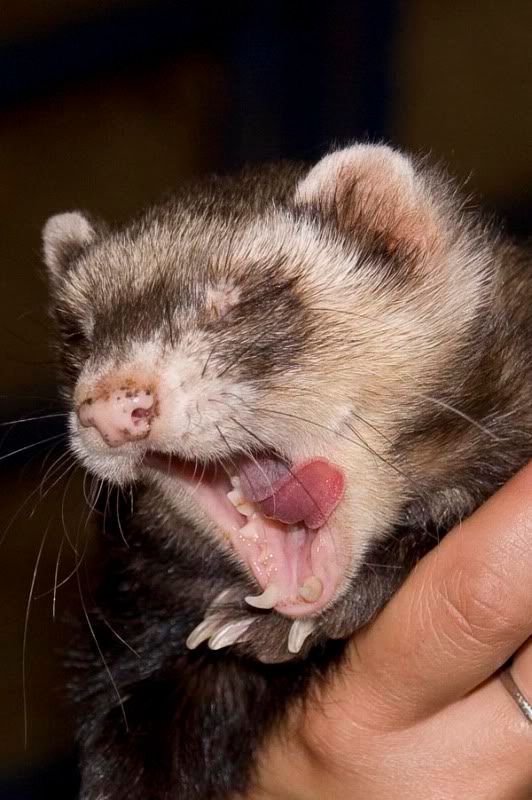 1) If your ferret enjoys raw meat or bones, raw food feeding them some of these foods can help clean their teeth. The tougher tendons in the meat can act like soft tooth brushes and gently rub away at plaque while the strong bones may help scrape off tougher tartar. Keep in mind that there are health risks to both ferrets and owners associated with feeding raw meats.
1) If your ferret enjoys raw meat or bones, raw food feeding them some of these foods can help clean their teeth. The tougher tendons in the meat can act like soft tooth brushes and gently rub away at plaque while the strong bones may help scrape off tougher tartar. Keep in mind that there are health risks to both ferrets and owners associated with feeding raw meats.2) A small amount of higher calorie dental cat food (a few kibbles every week or two) such as Science Diet will help scrape away some of the tough tartar. Keep in mind that most of these foods contain corn. If corn is a concern to you, consider feeding a few kibbles of high protein, grain free puppy food. These large kibble pieces will achieve the same goal as dental cat food, though without the taurine. These foods can be fed as an occasional treat or combined every so often (again, in small amounts) with regular kibble.
3) Regular tooth brushing. Regardless of which option you pursue (raw food or over sized kibble), bimonthly (or, if you are extremely dedicated to dental hygiene, weekly or even biweekly) brushing should be used to keep your pet's teeth in tip top shape. Options for brushing include gauze wrapped around a finger, ultra soft small cat or infant toothbrushes, and latex finger toothbrushes.

 Ferret safe toothpastes are limited to Ferret Dental Gel (not enzymatic, this toothpaste forces the owner to brush off as much plaque as possible) or enzymatic cat toothpaste (this must be rubbed on the teeth - the enzymes eat away at the plaque and tartar). Some owners prefer to skip the paste and simply use warm water to moisten the brush and rub the teeth clean.
Ferret safe toothpastes are limited to Ferret Dental Gel (not enzymatic, this toothpaste forces the owner to brush off as much plaque as possible) or enzymatic cat toothpaste (this must be rubbed on the teeth - the enzymes eat away at the plaque and tartar). Some owners prefer to skip the paste and simply use warm water to moisten the brush and rub the teeth clean. ***HUMAN TOOTHPASTE - EVEN TOOTHPASTE MADE FOR YOUNG CHILDREN AND BABIES - SHOULD NEVER BE USED ON YOUR PET.
How to brush:
Now here's the tricky part!
- Introduce your ferret to the idea over a few days or even weeks. Do this by gently rubbing their cheeks and teeth to get used to you touching their mouths.
- Allow them to sniff and interact with the toothbrush prior to having it stuffed into their mouths.
- Moisten the brush or gauze with warm water
- Apply desired toothpaste. Be sure to squeeze the paste deep into the bristles of the brush or finger toothbrush. This prevents the paste from falling off when dealing with a wiggly ferret.
- Gently brush the ferrets teeth, working out from the hard to reach molars inwards. Be sure to rub along the gum lines as this is where the tartar tends to build up. If you are using an enzymatic toothpaste, actually brushing the teeth is less important as though the action does remove some excess junk from the teeth, it is the enzymatic action that does the work. If you are using a non-enzymatic paste, gently brush away as much junk as you can see. If the animal would rather chew on the brush than have you brush their teeth (assuming that you are using a bristle brush), let them. This will, for the most part, achieve the same thing as your brushing and may be more fun for the ferret!
- Rinsing the mouth after wards is not necessary, however a nice treat of ferretone after the brushing will make the whole thing a more positive experience for the ferret.
4) If your ferret has an excessive buildup of plaque along their gums, having a professional get the situation under control may be a good idea. Once your ferret's dental situation in under control, keeping them in nice condition is much more manageable.

Things to watch for:
- Damaged teeth. If the pulp is not exposed and the tooth is not cracked to the gum, then keep an eye on the situation. Watch for signs such as your ferret favouring that side of their mouth, blackness in the tooth or at the base of the tooth, redness and inflammation at the base of the tooth. Favouring shows that the tooth is beginning to be a problem for the ferret and may need to be removed, while blackness and inflammation indicate infection and possibly ulcers in the area indicating a trip to the vet for some dental work in the near future.
- Black spots on the gum line may indicate ulcers. A vet trip is imminent and may result in dental surgery and medication to stave off infection.
- Red, inflamed gums may indicate early gingivitis. Early intervention is key and can decrease the likelihood of future complications. A trip to the vet would be beneficial to both your ferret and your pocket book (in the long run).
